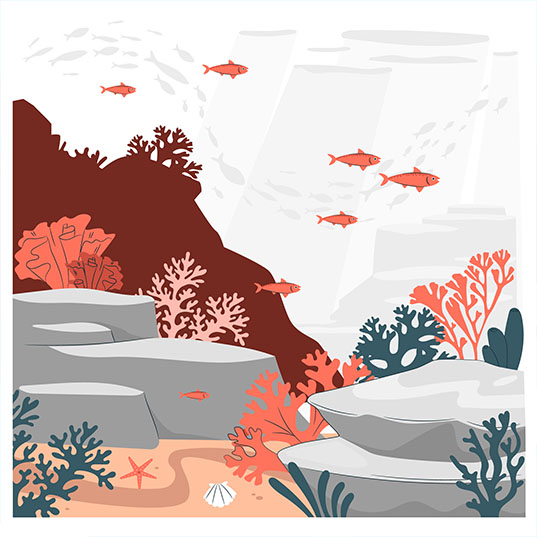A sense of awe lies at the heart of scientific inquiry. It fuels exploration and inspires the curiosity that drives innovation. In an era defined by global challenges, the act of marvelling reminds us that we are part of something greater. It broadens our sense of what is possible and helps guide us towards decisions that serve the common good.
The ocean is perhaps the most powerful embodiment of this. Vast, mysterious and essential, it represents an immensity that still manages to move us. Every 8 June, World Oceans Day encourages us to see the sea with fresh eyes — not simply as an expanse of water, but as a living system on which our survival depends.
In 2025, the United Nations captures the message with a slogan as clear as it is compelling: “Wonder: sustaining what sustains us.” A call to rekindle our emotional connection with the seas—and from that place of connection, take responsibility for their preservation.
In this article, we explore the main threats facing our oceans—from climate change and rising sea levels to acidification and overfishing—and speak to one of the most influential voices in oceanography to understand what sustainable regeneration means today and what scope there is for action.
What will you find in this article?
- Garbage patches
- Hunting in the oceans
- Destructive fishing
- Acid rain
- The water cycle
- Amaro Gómez-Pablos and two views on the future of the ocean
Garbage patches
 In recent years you may have heard mention of the Great Pacific Garbage Patch and 4 such islands of trash that float over Earth’s oceans. You’ve surely seen photos of an enormous accumulation of waste of all kind on the surface of the sea. These stains on the oceans extend for some 1.5 million square kilometers. The biggest occupies a surface 3 times the size of France and it is estimated that it contains over 2 trillion plastic items and pieces, 10 times more than there are stars in the Milky Way.
In recent years you may have heard mention of the Great Pacific Garbage Patch and 4 such islands of trash that float over Earth’s oceans. You’ve surely seen photos of an enormous accumulation of waste of all kind on the surface of the sea. These stains on the oceans extend for some 1.5 million square kilometers. The biggest occupies a surface 3 times the size of France and it is estimated that it contains over 2 trillion plastic items and pieces, 10 times more than there are stars in the Milky Way.
Overall, the 5 big patches contain more than 5 trillion plastic items weighing around 270,000 tons.
And they are growing, because every year more than 8 million tonnes of plastic end up in the oceans, killing 100,000 marine species and entering the global food chain.
Action to be taken to tackle hunting in the oceans
The sustainability of our oceans is closely linked to the state of the living creatures that inhabit them. Numerous species are endangered by human action, from the mass hunting of dolphins for consumption or mainly for sale to dolphinariums, to the persecution of whales for their meat or cosmetic use, to the fishing of sharks fished exclusively for their fins.
Destructive vs. sustainable fisheries
Destructive fishing - such as bottom trawling or the use of explosives - severely damages marine ecosystems and leads to the indiscriminate catching of species. According to the FAO, 37.7 % of fish stocks are overexploited, a critical level that continues to rise. At the same time, ocean acidification - caused by excess CO₂ - continues to worsen. In 2024, the level of acidity increased again, compromising marine life and reducing the ocean's capacity to absorb carbon.
Against this backdrop, sustainable fishing proposes methods that respect natural cycles and reduce environmental impact, and is key to preserving the oceans in the long term.
What is acid rain?
Acid rain is one of the consequences of atmospheric pollution and negatively affects the oceans. It is produced when polluting emissions from factories, cars and heating boilers and the like enter into contact with the humidity of the atmosphere. These emissions contain nitrogen oxides, sulfur dioxide and sulfur trioxide, nitric acid and sulfuric acid. The process also occurs naturally in volcanic eruptions.
Do you know the water cycle?
The natural hydrological cycle is becoming affected by changes in the climate, excessive water extraction, and pollution. Acidification of the oceans is a real, present problem which we must avoid.
Amaro Gómez-Pablos and two views on the future of the ocean
“We are the cause of the problem — fortunately, we are also capable of understanding the solutions... Let us restore everything we can while we still have the chance,” urged the inspiring scientist Sylvia Earle in an interview with journalist Amaro Gomez-López.
From their conversation deep down in the immense Pacific (200 meters below the surface), we created an amazing three-episode series also including unique images of the Galapagos Islands. Discover them embedded in this article.
Recently, Gómez-Pablos himself witnessed another marine regeneration story, this time in the waters of the Sea of Cortez in Baja California. There, he joined the pioneering project of the Mexican NGO ORGCAS, which works to transform former shark fishermen into tour guides specialised in the conservation of this keystone species. The initiative has not only succeeded in halting the decline of shark populations, but also in generating new economic opportunities for local communities.
Source:
https://www.un.org/es/observances/oceans-day
Source:
Journalist and content manager specialising in sustainability. Trained at the Carlos III University of Madrid, she works at the intersection between the environmental, the human and the organisational from a conscious and committed point of view.
Her texts seek to provide clarity and perspective, integrating a critical, conscious and documented look at the challenges of the present.
Collaborates in
Sustainability for allSpecializing in
Climate change
Sustainability
Environment